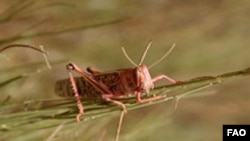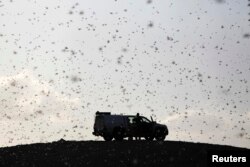A new satellite forecast tool could more than double the warning time for desert locust invasions, allowing vulnerable nations to prepare better against the crop-eating grasshoppers, the United Nations and European Space Agency (ESA) said Wednesday.
Desert locusts, found mainly in the Sahara, across the Arabian Peninsula and in India, pose a major threat to agricultural production when migrating in swarms, the U.N. Food and Agriculture Organization (FAO) says.
A one-kilometer-square swarm of about 40 million locusts can eat the same amount of food as 35,000 people in a day, according to the agency. FAO and ESA said they have developed a new remote sensing system that by processing satellite data on soil moisture and vegetation can predict the formation of swarms up to three months in advance.
"Longer warning periods give countries more time to act swiftly to control a potential outbreak and prevent massive food losses," said Keith Cressman, FAO's senior locust forecasting officer.
The tool is the latest in a series to apply satellite data to agricultural purposes.
For pest prevention teams, it is key to find locust breeding areas early in order to apply pesticides before grasshoppers grow wings and start migrating, Cressman said.
"Then you are chasing a moving target," he told the Thomson Reuters Foundation.
Best breeding conditions
Locusts breed in large numbers when good rains and rapid vegetation growth follow a period of drought.
Soil moisture data help authorities locate areas where the ground is wet enough for the locusts to lay eggs and to monitor them for signs of swarming.
Trials on data from a locust invasion in Mauritania in 2016 allowed ESA and FAO experts to identify hatching areas 70 days before the outbreak occurred.
That significantly improved upon current forecast systems based on satellite information of green vegetation that give a maximum notice of one month and sometimes give authorities just a few days to reach remote breeding locations, Cressman said.
"Often they are too late," he said.
Up to 100 percent of cereals and 90 percent of legumes were destroyed in West Africa in a 2003-05 plague that affected 8 million people and took 13 million liters of pesticide to be reined in, the FAO said.
Cressman said FAO is hoping to make the new tool available to all countries at risk by the end of the year.










